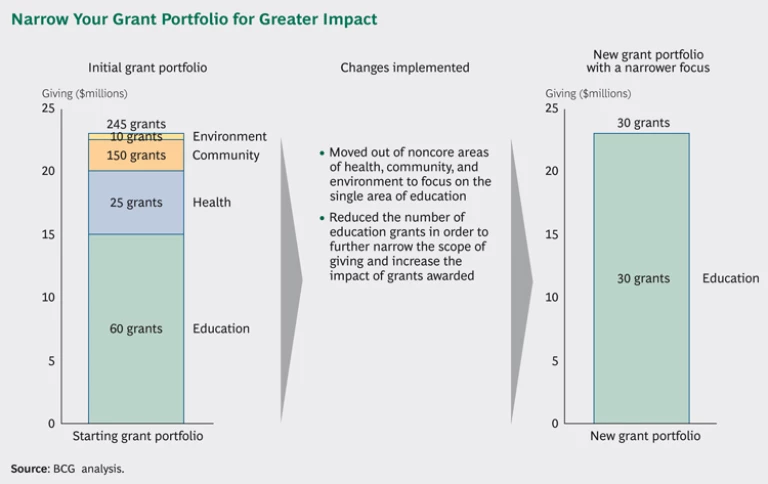The lingering global recession has given rise to a new normal of slow growth, ongoing budget constraints, and a focus on getting more value from tight resources. These pressures affect all aspects of a company’s business—including charitable giving. Faced with potential funding cutbacks and a need to do more with less, companies are seeking ways to get a greater return on their social investments.
The reality is that corporate giving does not always have the impact that many companies would like to see. Dwarfed by massive, well-funded philanthropies with enormous resources, corporate foundations contribute just 10 percent of the total giving by U.S. foundations. Corporate giving also tends to lack strategic focus. Companies are typically motivated by an obligation to give back, to be a good neighbor, and to support causes that are important to employees. As a result, donations are often fragmented and committed to causes that are unrelated to the business.
Perspectives on what corporate giving is and can be are evolving, however. Under the larger umbrella of corporate social responsibility, many companies are discovering that they can have a real, lasting impact on important social and environmental causes. At the same time, they can create significant value for their employees, businesses, and reputation—benefits that go beyond the traditional goals of corporate giving.
Starbucks, for instance, is committed to increasing access to education and training in the communities that produce its coffee, tea, and cocoa. Chevron has made the elimination of mother-to-child transmission of HIV a priority in Angola, Nigeria, and South Africa, where the virus affects employees and communities in which the company operates. And Pfizer’s Global Health Fellows program offers employees three- to six-month assignments to help address a range of global health issues in partnership with development organizations in over 40 countries around the world. The program gives Pfizer a better understanding of global health concerns and allows employees to use their skills to directly help those in need.
Recent studies have shown that activities such as these are an important tool for increasing employee engagement and commitment. They can also promote learning, as employees gain new skills at the same time that they transfer capabilities to the nonprofits they work with. Finally, they create important stakeholder relationships in markets that are critical to current operations and future growth.
The Boston Consulting Group recently surveyed a number of corporate foundations to discover how they went about developing an effective giving strategy. We identified six key imperatives for success.
Set a Clear Mission and Goals
What is the company trying to achieve with its giving program? Are there particular issues that connect to the core business or resonate with employees, business leaders, and stakeholders? An energy company might focus on the environment, for example, or a toy company might choose to work with a children’s health nonprofit. A clear mission statement clarifies why the company has chosen to support a particular cause, the purpose and goals of the program, what resources the company will provide, and what guidelines will be followed. Making deliberate choices about what activities or causes the company will and will not contribute to is important. The challenge here is aligning senior managers on the priorities and ensuring that they see the company’s charitable giving as a strategic lever rather than a funding pool for pet projects that fulfill near-term business goals or that are beyond the company’s strategic focus entirely.
Case in point: Merck makes significant, multiyear commitments of charitable contributions to enhance awareness of and expand access to health initiatives within the therapeutic areas that the company is most knowledgeable about. For instance, it pledged to contribute $15 million through 2013 to launch a program that addresses the growing problem of health care disparities related to type 2 diabetes among low-income and underserved adults in the U.S. Activities such as these have a clear mission and goals, leverage Merck’s expertise, address important social issues, and engage employees and external stakeholders.
Narrow Your Focus and Manage for Impact
Many companies dilute their efforts by managing a highly fragmented portfolio with many small grants devoted to a wide range of causes. To have a greater impact, consider giving more money to a small number of causes that align with your company’s business, and build expertise over time in those key areas. (See the exhibit.) This focused approach is also a more effective way to build a positive association with the company’s brand. For instance, all of the Nike Foundation’s funds and activities focus on “the Girl Effect”—the potential for 250 million adolescent girls to end poverty for themselves and the world. This single topic offers a clear story, builds credibility and expertise, and focuses efforts to deliver real results.
It’s also important to set clear metrics that measure social impact and progress toward the goals of the company’s program. Rigorous measurement and monitoring of results ensures that the program stays on track and achieves the desired outcomes.
Choose the Right Partners
After identifying the goals of the program and the issues your company will focus on, the next step is to choose partners that can help achieve the program’s goals and sustain its efforts beyond the funding period. Look for companies with complementary skills and goals, as well as nonprofits that can help design and execute the program.
Identifying the best nonprofits to partner with is a matchmaking process that goes beyond just ensuring a fit with the chosen focus area. Matching the skills that your company has to offer with the needs of the nonprofit will lead to stronger, more collaborative partnerships. Get to know potential partners and make sure that expectations are aligned. In our experience, long-term, strategic partnerships deliver the most value to a nonprofit, so choose just a small number of organizations as partners. For instance, one company we worked with launched a program with just ten NGOs around the world and made significant investments to develop their skills in technology, project management, and other program-related capabilities.
Another issue is ensuring that the partner is willing to give your company input, recognition, and stakeholder visibility. A very large, brand-name foundation or nonprofit can overshadow your company’s efforts.
Get the Business Involved
Traditionally, decisions about corporate giving were made with little input from the business. While the nonprofit status of foundations requires that grants have no direct commercial benefit, the business leaders still must be involved to ensure that corporate giving is aligned with the needs of the community, generates stakeholder goodwill, and enhances the company’s reputation. Maintaining legal compliance while achieving these objectives can be accomplished in several ways: by holding annual “big ideas” forums with business leaders and key NGO partners; involving business leaders in the grant evaluation process; or having business leaders act as champions for specific grants or giving areas. Some companies make a practice of mapping out key issues and stakeholders in order to better understand what investments will deliver the greatest social and business impact.
Create a Communications Strategy
The growing importance of corporate social responsibility has made businesses realize the need for an effective communications strategy. Such a strategy helps raise awareness of the social impact of the company’s giving program, and sharing the success of corporate-giving efforts helps establish the company’s commitment locally or globally. It is therefore critical to share the value of these efforts with employees, the community, and other key stakeholders. Companies also need to ensure that their business leaders are fully aware of the corporate foundation’s activities so they can publicize them internally and externally.
Select the Right Structure
A corporate-giving program can be set up as a separate foundation or be funded as a business expense. A foundation is a separate tax-exempt organization, with funds that are put aside for charitable purposes only. This prefunding helps a corporate foundation navigate annual corporate budget fluctuations and enables it to make multiyear investments and stay committed to its areas of focus.
A foundation can also attract external talent from NGOs and other nonprofits that have valuable skills and networks, and it can open doors to partners that would otherwise be unwilling to engage directly with companies. The drawback, of course, is that it limits giving to nonprofit organizations, restricting the types of charitable giving a company can do. Moreover, if not well managed, this separation can cut a foundation off from the needs of the business. Best-practice companies engage the business closely but provide clear compliance guidelines.
Finally, a foundation structure requires additional overhead and resources to deal with activities such as managing the foundation’s funds, filing foundation tax returns, and creating and managing a board of directors.
Direct corporate giving that is treated as a business expense is more flexible than a foundation in terms of how donations can be used and how involved the business can be in directing the giving activities. But a foundation is generally considered a marginally better structure because it allows for the execution of long-term giving strategies.
Once isolated from the business and lacking strategic focus, corporate foundations are evolving into high-impact, brand-building programs that increase employee engagement and community goodwill. By following these six guidelines, companies can create an effective giving strategy—and achieve a far higher social return on investment.








